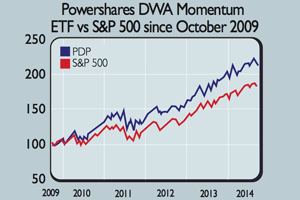Buy high, sell higher: riding the momentum investing wave
Betting that price trends will continue is a very risky strategy, says Phil Oakley. But it can also be very profitable.
How do you make money in the stockmarket? Conventional wisdom says you must buylow, sell high'. Find cheap, unpopular shares whose potential is being ignored by the market, and wait for everyone else to catch on.
This is value' investing as practised successfully by the likes of Warren Buffett and his mentor, Ben Graham, and it makes intuitive sense.
But there's another profitable strategy that's a lot harder for people to get their heads around. It's perhaps best summed up as buy high, sell higher'. This is the basic idea behind what's known as momentum' investing.
Subscribe to MoneyWeek
Subscribe to MoneyWeek today and get your first six magazine issues absolutely FREE

Sign up to Money Morning
Don't miss the latest investment and personal finances news, market analysis, plus money-saving tips with our free twice-daily newsletter
Don't miss the latest investment and personal finances news, market analysis, plus money-saving tips with our free twice-daily newsletter
You buy whatever has been going up in the recent past (or short sell whatever has been going down) be it shares, bonds, currencies or commodities. You then hope that the trend continues long enough for you to make money from it.
This strategy has nothing whatsoever to do with fundamentals', such as profits, growth prospects or valuations. It's all about betting that price trends will continue. In this sense it is a very speculative, risky strategy but history suggests it can work very well indeed.
In his book What Works On Wall Street, James O'Shaughnessy shows compelling evidence that momentum investing has been a good way to beat the stockmarket.
Between 1927 and 2009, if you had bought the 10% of shares thatsaw the strongest price gains over the previous six months, then held them for a year before repeating the process, you would have made 14.1% a year. That's a good bit above the 10.4% a year returned by the wider US market.
The strategy also worked over shorter time periods. In fact, flying in the face of many value strategies, O'Shaughnessy even goes so far as to say that buying the worst-performing stocks is only really worth doing at the bottom of bear markets such as 1973/1974 or 2009.
How does it work?
Some experts suggest that even though investors are flooded with information about firms and markets, the professionals can be quite slow to react to it. For example, firms have become clever at guiding analysts as to future profits.
They release good news in dribs and drabs rather than in one go, so you'll see a seriesof rising profit forecasts, rather than just one big upwards revision. This can explain why share prices that may already have gone up a lot can keep going. (And on the short-selling side it's reflected in the old stockmarket adage that profit warnings come in threes'.)
But like anything in the market, it's not easy and there are no shortcuts. To be successful at momentum investing you need nerves of steel. The shares involved tend to be very volatile (they move up and down a lot).
You also need to be able to sell quickly. In the late 1990s, dotcom shares had a lot of upward momentum but when the bubble burst they plunged in value or went bust and disappeared.
Practical problems
Momentum strategies also involvea couple of practical problems youmust be aware of. If you buy and sell shares frequently, you will end upshelling out a lot of money in broker commissions and stamp duty. This willeat away at your returns.
It is alsobest to practise momentum investing in a tax-efficient wrapper, such as an individual savings account (Isa) if you do well, you might end up with big capital gains, which you won't want to have to pay tax on.
Spotting promising trades
So how do you spot a promising momentum trade? Firstly, look out for investments hitting new highs (or lows if you want to bet on further share-price falls).
Secondly, pick shares or investments that show the highest relative strength this is the difference between an investment's price movement and its underlying market over a set period of time, such as six months.
Finally, look at moving averages.These are the rolling average price ofan investment over periods such as 50 or 200 days. An investment where the price rises above its moving average may be a sign that it has positive upwards momentum.
How to give your portfolio momentum
To be good at momentum investing takes a lot of time and effort, and the ability to move fast. It is also very risky, particularly if markets turn against you. So if you want to use this strategy in your own portfolio, it is probably best to own a fund or exchange-traded fund (ETF).
Not all such strategies work. The AQR Momentum index, which replicates a momentum strategy, has performed broadly in line with the S&P 500over the last fiveyears. But one
success story isThomas Dorseyof Dorsey Wright& Associates.

A London-listed alternative could be therecently launched iShares MSCI WorldMomentum Factor (LSE: IWMO), whichbuys global shares with the highest risk adjustedperformance for the past six to12 months. It has a total expense ratioof 0.3% and can be held in an Isa.
Get the latest financial news, insights and expert analysis from our award-winning MoneyWeek team, to help you understand what really matters when it comes to your finances.
Phil spent 13 years as an investment analyst for both stockbroking and fund management companies.
After graduating with a MSc in International Banking, Economics & Finance from Liverpool Business School in 1996, Phil went to work for BWD Rensburg, a Liverpool based investment manager. In 2001, he joined ABN AMRO as a transport analyst. After a brief spell as a food retail analyst, he spent five years with ABN's very successful UK Smaller Companies team where he covered engineering, transport and support services stocks.
In 2007, Phil joined Halbis Capital Management as a European equities analyst. He began writing for MoneyWeek in 2010.
-
 Will “Liberation Day” strike again?
Will “Liberation Day” strike again?Donald Trump’s 90-day tariff pause comes to an end on 9 July. Can we expect further market turmoil?
-
 Israel claims victory in the '12-day war' with Iran
Israel claims victory in the '12-day war' with IranDonald Trump may have announced a ceasefire in the 12-day war between Israel and Iran, but what comes next depends on what happens internally in Iran